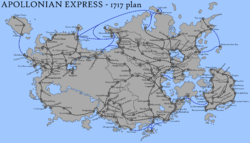Apollonian Express
 logo of the Apollonian Express company | |
| Overview | |
|---|---|
| Status | Under Construction |
| Location | Apollonia |
| Offices |
Headquarters: Regional offices: Operational bases: |
| Stations |
132 rail stations 17 sea ports |
| Routes |
30 rail routes 14 sea routes |
| Operation | |
| Opened | TBA 1694-1700 |
| Operator(s) | Various |
| Technical | |
| Track gauge | 1,435 mm (4 ft 8 1⁄2 in) |
| Electrification | 25 kV AC |
| Operating speed | Various |
| Route | |
| Map |
 |
| Route | Template:Apollonian Express Route |
The Apollonian Express is an international transport company headquartered in the Senyan capital of Svorgas. Also registered in Çakaristan and Hurmu, the company operates passenger and freight train services, owns track and other railway related infrastructure, as well as operating international freighter and ferry services across Apollonia, Lyrica and surrounding islands. The company currently operates several routes and is in the process of constructing and opening several more, with the project currently spanning 14 nations across Micras.
The modern company was founded in 1702, but the idea of an initial trans-Apollonian railway were first made in 1590, when Senyan representatives put forward a plan for a circular route around the continent. However, whilst some small sections of the route were built, notably in Senya and Apollantis, the full plan never came to fruition due to political instability on the continent.
In 1694, the project was revisited by representatives of Senya and Çakaristan, who both signed a working agreement on linking their extensive rail networks. This time, the plan also included neighbouring states who were extensively consulted on the project With the construction of the Blackfriar's International Station in 1695, as one of its terminus stations. Momentum started to build for the project. The Apollonian Express company was incorporated in 1702 AN in Çakaristan, Hurmu and Senya, with the mission of the company to provide unabridged links for both passenger and freight goods across the continent. The company has spent the following 15 years working with partners in various countries to expand the project and to connect the continent. With the re-integration of Jingdao into Shireroth and the thaw in relations between Çakaristan and Nouvelle Alexandrie, the Apollonian Express is hoped to provide a way of ensuring lasting peace and economic prosperity across Apollonia.
The company itself makes most of its money from freight traffic, where the service ensures a quicker and more direct links than traditional sea-faring freighter ships, and provides greater access for trade integration across the continent. In addition to the freight services, the Apollonian Express often operates international passenger services, and the occasional domestic service, on behalf of local and national rail operators. Special trains are sometimes put on by the company, often to provide additional transport to cultural and sporting events.
The project also aims to standardise the railways across the continent and build up and improve transportation infrastructure across the continent. Following the initial reboot of ideas in 1694, Çakaristan began to modify its railways to bring them up to international standards. The implementation of standard gauge is hoped to ensure that railways across the continent can become more standardised and interconnected.
History
Initial 1590 plan
The first proposals for an Apollonian Express were put forwards in 1590 by Senyan representatives who proposed an almost circular route around the Apollonian continent. Their original route would have ran from Tyrasia in Kyrovistan, clockwise through Gerenia, Safiria, Brogenia, the then Ocian territory of the Walker Democracy, across the Babkhan territory of Nuristan, before traversing Gralus, going as far north as the capital of Shelsa, before darting southwards through the Storish region of Hålogarike to the city of Ghawlama in Hurmu. From there it would continue south-west, through Antica, Flanders, the Natopian territory of Saint Andre to Apollantis, before crossing into Kildare, going north-west before arriving in Senya, cutting through the cities of Tiga and Dyas before arriving in Tirlar, before going north into Storej, completing the journey at the Storej capital of New Pyongyang. A further Craitish extension to Cherry Trees was also proposed. By 1596. portions of the route had started being constructed in Apollantis, however the full line was never completed thanks to the instability of several of the nations across Apollonia, which were being connected to parts of the Kildari rail network, which had been constructed in 1558, however these lines were only ever partially completed.
As Senya were one of the few nations on Apollonia that did not suffer from political instability, it was able to slowly establish an extensive domestic rail network, which included long distance cross-country routes, as well as smaller regional and commuter lines, and additionally built its own connections to neighbouring countries. Prior to Kildari independence, a Svorgas–Port Nevermore line had been built, which was closed due to the events of the River Warrior War in 1618, prior to a line out to Tirlar in Arboria being opened in 1668. Passenger services to Port Nevermore (now Yuanbeicheng) resumed in 1685, as well as the construction of a mainline to Daocheng in Jingdao. The Svorgas–Daocheng line was founded as a 50%-50% venture between Senyan Rail and Kirudofea, with all lines out of Senya running under the Senyan Rail umbrella.
Re-establishment of plans (1694)
Whilst suggestions had always rumbled about re-booting the old Apollonian Express project, formal talks began in 1694 after the initiative was picked up by the authorities in Çakaristan. With the collapse of Gralus, new plans will route the train's path through Lac Glacei with support from the grand duchy.
The proposal of 1694 would see several routes operated under the Apollonian Express banner with the Senyan capital of Svorgas and the Çakari capital of Agra becoming central hubs of the railway. The line from Svorgas to Jingdao would be extended through southern Jingdao to Sint Anna in Alrig, with the Svorgas–Yuanbeicheng and Svorgas–Vancona routes being added to the Apollonian Express banner but being served as connecting services. The Svorgas–Tirlar route would also be extended out to Hawshire with a new tunnel. There would also be a new Svorgas–Agra route, which would run north through Senya to Hreĵnɏeg, where the train would cross the Camoleo River into Jingdao, where it would travel eastwards across Qyzylqaystan through to Çakaristan. An additional line between Xiacheng and Cundiyangshu would traverse Jingdao in order to connect up the Svorgas–Sint Anna and Svorgas–Agra services.
In the east, a service would run between the Florian city of Dragonmoor and Maulikpur in Çakaristan, as well as from Dragonmoor through to Agra southwards via Manbai. A service between Agra and the International Mandate's capital of Tiegang would be established, with a final line, a service between Fatehpur and Ghawlama in Hurmu being established, that would traverse through south-eastern Floria would also be established, with trains separating in half at Ghawlama, with one section carrying on into Lac Glacei where trains run services circumnavigating Lake Glacei, as well as carrying on out east to Ergo Sum, whilst another part would carry on out into Arbor, where it would reach Madinat al-Fath.
To the north, a line would terminate at Alexandretta in Meckelnburgh, crossing the border at New Millaro. The route would utilize dual gauge along Meckelnburgh's preexisting southern rail corridor. However, the route is uncertain as of 1699 AN, as a connection across the Green is required.
Additionally, Craitland and Thracistan would be connected up to the railway by freighter services, with the Craitish line between Cherry Trees and Osĵätoņ (via Mainlae) coming under the Apollonian Express brand.
Apollonian Express services would share the lines with local trains, though will be given priority, whilst the lines will also be used for Apollonian Express freight movements and special trains (such as for those of visiting statesmen and for services for cultural and sporting events).
Issues
The construction of a trans-continental railway inevitably through up a number of issues, that those creating the railway would have to resolve.
Jing-Florian distrust
Due to its troublesome relations with its neighbour Floria, Jingdao - under the leadership of Jin San, who had been born after the War - reluctantly warmed up to the idea of opening the borders. Heavy border controls and disinfection of anyone entering Jingdao at the Florian border, were proposed as possible solutions to the 'Florian problem'. In the end, the Florian administration blocked the proposal to connect the railway with the Jingdaoese lines. The decision was sheered upon by most of the Jingdaoese population, who celebrated the decision by throwing eggs at a puppet of the nation's president. The decision to block routes through Jingado and Floria was reversed in 1702 AN.
Çakaristan gauge
Another issue was the wide variety of gauges used in Çakaristan compared to other nations on Micras. With much of Apollonia running on standard (1,435 mm) gauge, Çakaristan decided to adapt its lines along its route, using dual gauges to ensure that Apollonian Express trains could enter its territory without a gauge break.
Post-Chidao Troubles
In 1695, civil unrest started in Jingdao which lead to widespread protests and political instability that threatened the completion of the project. In response, Senya decided to focus on upgrades to the network within its borders and to the lines out to Arboria and Hawshire, whilst announcing increased security checks on trains coming in and out of Jing territories. Since the foundation of the Great Apollonian Empire and the cessation of hostilities, train services could take place again.
Arboric Civil War
In 1701 AN, the Arboric Civil War began which halted the construction of the railway between Ghawlama and Madinat al-Fath.
Norfolk Isles Confrontation
After the successful annexation of Port Balaine by Floria and Thracistan becoming incorporated into Çakaristan, this created instability around the archipelago causing disruption to ferry routes with a large buildup of Florian navy vessels blocking the routes in retaliation to the Kadim Treaty and protect the national interests of the Florian State. This was resolved by 1723 AN.
Hrithik's rebellion
During the 1720s, Hrithik Çakar gained a foothold in western Tartaristan in his rebellion against the Shahanshah. Train service on the route Xianyoumi - Tartarvistar - Jeevitchinar was continued for some time. In 1727 AN, the train service was curbed.
1728 Khordad Floods
In 1728 AN, floods occurred in the south-western parts of Çakaristan. This caused major damage to railways, including the Suryapur-Fatehpur route. Train traffic was curbed.
Routes
One solution the Apollonian Express came up with to prevent any nations/areas being cut off was to create multiple routes to ensure that in the case of a border closure, traffic could be rerouted via a different line to ensure that the movement of goods and people would face minimal disruption. The plans are for 24 passanger services and 13 ferry/freighter services to be reguarly operated, though the entire network is designed so that freight travel and special trains may be scheduled according to need (for example, a freight service could run directly between Tiegang and Svorgas, where as passengers would have to change at Agra, Suryapur and Hreĵnɏeg). The network will serve 116 railway stations across 10 nations, and 14 sea ports across 10 nations. Overall, 14 nations will be part of the project, with four (Dark Berry Islands, Jääland, Meckelnburgh and Thracistan) exclusively being served by ferry/freighter services.
Construction by country
| Nation | Planned extent | Construction status | Border/Customs requirements | AE Rail Depot(s) |
|---|---|---|---|---|
| The Xiacheng–Dragonmoor–Maulikpur, Dragonmoor–Agra, Agra–Suryapur, Agra–Tiegang and Suryapur–Fatehpur lines in Çakaristan to operate AE rail services, with sea freight services connecting the cities of Fatehpur, Manbai and Sint Anna with each other and Kadim. Branch line to run from Ghawlama through to Madinat al-Fath via Mursiyah. | Many lines in Çakaristan are awaiting electrification upgrades. | Unknown | Unknown | |
| Port of Osĵätoņ to connect with AE-sponsored sea freight route connecting to Hawshire. Potential for Cherry Trees–Osĵätoņ line via Mainlae to operate AE services. | Unknown | Unknown | Unknown | |
| Sea freighter/passenger service to run from Mountainview Bay to Ergo Sum in Lac Glacei, and between Mountainview Bay and Cossa in Vegno. | Unknown | Passengers to receive a basic passport and customs check upon departure, and full passport and customs check upon arrival. | None | |
| Xiacheng–Dragonmoor–Maulikpur and Dragonmoor–Agra lines, with the lines separating after Eastham. Potential for Suryapur–Fatehpur trains to cross Florian territory to allow for the commercial connectivity of Fatehpur with the rest of the Great Apollonian Empire. | Line was fully constructed in 1705 AN. | Border checks on the Kildarian and Çakari border. | Unknown | |
| All major population centres in Apollonian Hurmu to be connected
|
As of 1705, lines extend from the frontier to Ghawlama. Still in construction are the Tyrador to Ghawlama and Tyrador–Askuhafn lines, and the extra lines with regard to Eesdeheito and the connections to Çakaristan, with the anticipated completion of the aforementioned works due by 1708 AN. New bridge between Vadimbaatar and Al-Khadra being built (projected 1710) | Border controls with Çakaristan and Barikalus (no Border control to Al-Khadra and Qurtuba). Reduced border control with Senya in accordance with Xäiville Convention (fast check of freight documents and passports). See Visa policy of Hurmu for more information. | Mitrovska | |
| Blackfriar's International Station to serve as a terminal on the Agra–Tiegang line. | Only station was completed in 1695. | Unknown | None | |
| Orbital railway around Lake Glacei, with a branch line out to Ergo Sum from Jardin, with a line connecting to Ghawlama in Hurmu from Rhinford. Sea freighter/passanger service to run from Ergo Sum out to Mountainview Bay in the Dark Berry Islands. | Circuitous route around Lake Glacei complete. Spur lines under construction as of 1702 AN. | Border checks in place. Restrictions on firearms, plants and animals. | Monte Glacei, Jardin, Rhinford | |
| Freighter/passenger service from Alexandretta to Senya. Railway first designated from the south via Ashinthael, via Slograde to Sanktago and diverge at Alexandretta. Northern line runs St. Cloud to terminate at Tuft and south line terminates at Victoria. | Harbor facilities completed. | Expedited customs for AE passengers with visas available upon arrival. | Tuft (terminal), St. Cloud, Victoria (terminal), Alexandretta, Sanktago | |
( |
Through line to run between Hawshire and Svorgas | Line completed between Tirlar and Dyas. | Passport and customs inspection for the Natopian-Senyan border takes place at Meiridosa station. | Unknown |
| Lines from Svorgas to Yuanbeicheng, Hawshire, Vancona, Port Nelson, and Daocheng to operate AE services, along with the Hreĵnɏeg–Suryapur line. | Lines fully completed, with the exception of the line out of Hreĵnɏeg towards Suryapur, with bridge/tunnel option yet to be decided. | Craitland: Passport control conducted at station preceding border.
Natopia: Customs officials and passport control alight at Dyas and Meiridosa to complete checks. Freight services stopped at Bordelor for checks. |
Dyas, Hreĵnɏeg, Jogasim, Sanyanska, Svorgas, Vancona. | |
| Through line to run between Hawshire and Svorgas Svorgas–Daocheng, Svorgas–Yuanbeicheng, Daocheng–Sint Anna, Hreĵnɏeg–Suryapur, Xiacheng–Cundiyangshu lines in Jingdao to operate AE rail services, with sea freight services connecting the cities of Fatehpur, Manbai and Sint Anna with each other and Kadim in Thracistan. |
Svorgas–Daocheng and Svorgas–Yuanbeicheng lines are fully operational. | Floria: Passport control. Florian citizens are not allowed entrance into the country via Xiacheng-Dragonmoor line without approval letter of the Shirerithian embassy.
Other nations: Passport and customs inspection. |
Unknown | |
| Sea freighter/passanger from Cossa to Mountainview Bay, line extension from Jorvik to Cossa in the Cossa–Ergo Sum line and intra-national line Cossa–Mhazar–Taurasi. | The construction has begun in 1717 AN and the complete activation of the lines is scheduled for 1720 AN. | Lac Glacei: Passport checks in Jorvik station for Lac Glaceian citizens. Visa-free travel for 90 days.
Dark Berry Islands: Passport and customs inspection for Dark Berrian citizens. Visa required. Restrinctions on firearms for all travellers. |
Cossa, Taurasi |
Participating nations
The following nations have indicated their participation in the Apollonian Express initiative of 1694 AN in alphabetical order:
 Arboria (Natopia)
Arboria (Natopia) Çakaristan
Çakaristan Craitland
Craitland
 Floria
Floria Hurmu
Hurmu International Mandate
International Mandate Lac Glacei
Lac Glacei Meckelnburgh
Meckelnburgh Senya
Senya Shireroth
Shireroth
 Vegno
Vegno
Trivia
- The Meckelnish painter Lucienne Arthur created a painting of the Apollonian Express:


